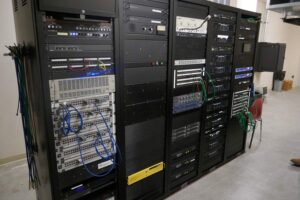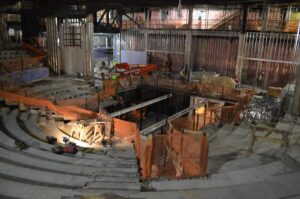Choosing Between Performance Equipment Upgrades or a Venue Renovation
In the second half of the 20th century there was an explosion of performing arts venues built on college campuses, in city centers, and in more far-flung areas of the United States. Baby boomers born in the postwar years were coming of age, going to college, and there was a need to build new venues for theatre, opera, dance, and music. Some of the buildings built during this time have aged gracefully with the programs they were designed to serve. In many instances however, some of these spaces are now 40, 50, or 60 years old, and while they have served their communities well, they need significant upgrades.
Before modifying an aging venue, it is useful to consider the scope of the improvements needed in the short and long terms, and to consider how even modest long term thinking can help guide the process. Below are four (4) types of building interventions and some thoughts about where and when each strategy may be appropriate.
- Loose Equipment Upgrades
The skilled staff who work in performing arts venues are accustomed to mounting increasingly complex shows, concerts, and events despite the aging infrastructure around them. They have frequently developed workarounds for outdated equipment, and they are skilled at keeping these venues operating in, at times, suboptimal conditions. For many venue managers working on college campuses or within larger institutions, there are loose equipment systems that can be easily upgraded such as:
- production lighting fixtures
- loudspeaker inventories
- projectors and screens
When scarce funds become available to venue managers, these types of upgrades are relatively easy to purchase, requiring minimal venue downtime and they can sometimes be installed by existing production crews with minimal outside assistance. Theatre consultants can help venue users to specify this equipment, but professional guidance is not always necessary. In short, these upgrades can be simple for users to make, and are essential to keep a venue functioning. However, modest equipment upgrades typically only keep things running and competitive but don’t improve the building’s infrastructure.
Loose equipment can be replaced or upgraded in response to production needs, but it is best upgraded in the context of a larger plan for the venue.
- Fixed Equipment Upgrades

Equipment racks for audio or lighting make upgrades easy for some parts of the system. Photo by Paul Sanow, ASTC
Some equipment systems are permanently installed but can be upgraded with a bit more effort, including:
- Replacement solutions for dimmer racks, lighting controls, or house lighting
- Replacement or major upgrades to sound, video, and communication systems
- Machinery controls upgrades
- Seating replacement
Some equipment systems are built into the venue’s architecture including:
- manual or mechanized rigging systems including, fire safety curtains
- mechanized stage lifts and orchestra pit lifts
- mechanized orchestra acoustic reflectors
These systems are integral parts of the venues they serve and can be more difficult to replace or retrofit into an existing space that does not have them. Theatre consultants are well positioned to help plan, specify, and oversee the installation of this type of equipment. Ideally, these upgrade projects would be considered in the context of larger venue improvements since they may be more expensive, complex, and disruptive to venue operations. Replacing these types of systems or installing them new in existing venues may also require:
- structural engineering oversight – where existing building structure might require modification to support new, different, or increased loading from technical systems
- electrical engineering oversight – where new systems have different electrical power requirements
- localized architectural upgrades – where existing architectural elements like walls, doors, corridors, and egress routes need to be modified alongside technical systems
- interior design modifications – where technical systems require new finishes that must coordinate with existing finishes, for example on floors and facias of a new orchestra pit lift to match existing floors and facias
Fixed equipment systems can be replaced or upgraded, but they are best addressed in the context of a larger plan for the venue, and more planning or design work is almost always needed.
- Technical Infrastructure Upgrades
As more complicated improvements are needed to meet the needs of the venue operators, greater intervention may be required. Technical infrastructure upgrades may include:
-
- Added fly tower height
- Stage grid reconstruction
- Audience chamber ceiling height, room dimensions, and general arrangement
- Adjustments or improvements to lighting catwalks and other technical positions and accessways
Such modifications often trigger upgrades to other building systems like sprinklers and fire detection systems, modifications to walls that define a venue’s fire separation boundaries, mechanical systems, upgrades to circulation and egress paths including accessibility accommodations to comply with the Americans with Disabilities Act, etc. For upgrades to many midcentury venues, it may be necessary to address asbestos and other contaminates. Clients will need to engage architects or engineers to take responsibility for oversight of these supporting infrastructure systems and file drawings with the local authority having jurisdiction (AHJ). Theatre consultants are needed to plan these types of upgrades and coordinate to ensure that the design team understands how the client’s goals bear on the full scope needed to upgrade the building.
Technical infrastructure upgrades can be standalone improvements, but they are best made in the context of a larger plan for the venue.
- The Architectural Renovation

Some renovations are more complex. In this case, the auditorium seating was completely reshaped, and a new stage house constructed to serve the needs of the theatre. Photo by Paul Sanow, ASTC.
Many venues are ripe for a major renovation or a series of smaller, phased renovations to address a host of issues. When considering the renovation of a venue, clients should consider developing a long-term conceptual plan and a strategy to make the improvements they need over time, and to allow smaller upgrades to be made in a larger context to prevent redundant work. Formulating answers to the following questions can serve as a first step toward developing a conceptual plan:
- What functions are the venue not currently performing that are desired in the future?
- What types of events are not presently supported by the venue?
- Are there issues with background noise levels, loading in and loading out of materials circulation or space constraints, or other aspects of the venues that do not support the long-term goals of the users?
- Is more space needed to support events or the organization’s mission?
- Can significant upgrades be made to the venue with minimal disruption to existing major building systems like structural walls, roof trusses, foundations, large duct chases, or the venue’s electrical service? Will an addition be required?
- What building systems will require replacement in the foreseeable future?
These questions are best answered as part of a study or concept phase where responses can be distilled into a preliminary vision describing how the client wants their renovated venue to function. A theatre consultant can collaborate with the venue owner to prepare this type of conceptual plan. A conceptual plan can be general and provide sketches of a reimagined venue with technical features and a list of items to be developed in future phases, providing a venue owner with a ‘north star’ that informs future steps in the renovation process. Alternatively, a conceptual plan can be more detailed and specific to include drawings, a program, assessment of structural and MEP systems, preliminary costing information, and potential project phasing. A venue owner should engage a team of design professionals including a theatre consultant to assess the existing venue, its many spaces and technical systems, and summarize findings for how the venue could be modified to serve the client’s future goals. Sometimes to satisfy a client’s budgets, the desired upgrades can be phased over time.
Conclusion
Regardless of how clients choose to address the various challenges facing their aging venues, planning is essential. A concept plan does not need to be expensive but can provide critical thinking to guide later phases of renovations and upgrades. The concept plan can evolve over time to suit evolving client needs but most importantly it brings informed clarity to the client’s thinking about their facility and how to craft a plan for long-term success.
By Michael Parrella, ASTC
Disclaimer: Any views or opinions expressed in this article are solely those of the author and do not necessarily represent those of the American Society of Theatre Consultants. This article is for general information only and should not be substituted for specific advice from a Theatre Consultant, Code Consultant, or Design Professional, and may not be suitable for all situations nor in all locations


